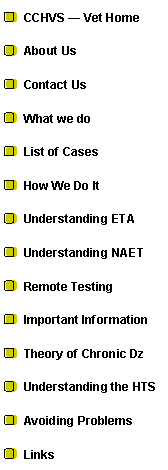





|
$24.95 + S&H for Single books.
20% Discount + S&H with orders of 5 books or more.
30% Discount + S&H with orders of 10 books or more.
Please have Credit Card Handy. We accept Visa, MC & Discover. CA Residents add 8.25% Tax.
OR Call us at: 877-843-6790 or 530-666-7322 |


|
Special interest in chronic or unresolved conditions. |

|
Phone: 530-666-7322 Fax: 530-666-7430 Remote Testing: 530-666-7300 Email: holisticvet@hughes.net |
|
To contact us: |
|
Please bookmark this page so you can return to it easily. |
|
Nutrition Case # 2: Twenty-Three Year Old Gelding with Failure to Thrive and Grade III/V Holosystolic Heart Murmur Responds to Concentrated Nutritional Supplements
Bert H. Brooks, DVM Cache Creek Holistic Veterinary Service Woodland, California
Abstract: (Published in JAHVMA, 6/26/2007) A twenty-three year old rescued Thoroughbred X Quarter Horse gelding showed marked signs of cardiac disease based on results of physical examination and careful cardiac auscultation.1 Cardiology referral for cardiac evaluation was rejected by owner due to financial restrictions and the fear of a poor prognosis. Blood tests were not taken for similar reasons. The patient’s teeth had been properly floated (no dental points observed) three months previously and he had been receiving an abundance of high quality feed since that time, but he remained in poor condition. Treatment with concentrated nutritional supplements administered orally produced positive results within thirty days.
History: On April 19, 1997, we responded to a request from a new client to examine a twenty-three year old chestnut Quarter Horse X Thoroughbred gelding named Shasta because of “failure to thrive.” Shasta had belonged to the present owner over ten years previously, but when she got married and had children, she reluctantly “gave him up to a good home” because of inability to afford the expense of owning a horse. Recently her family had moved to the country and she paid her old equine friend a visit. She found him in poor condition, neglected in a pasture and decided to “bring him back home” three months prior to our examination. At that time, his owner had Shasta’s teeth floated by another veterinarian. Because of economic restraints, blood tests were not performed but appropriate vaccinations and anthelmintics were administered and he was placed on a high plane of what should have been adequate nutrition – i.e., a mixture of abundant (left over feed was also abundant, indicating that a greater than sufficient supply was available) high quality alfalfa and oat hays with a two pound coffee can of commercial mixed grains barley, corn oats with molasses were fed twice daily. In spite of these efforts, after three months, his condition failed to improve and the owner called my service for a second opinion. Examination: When we examined Shasta we found that his temperature and respiratory rate were within normal limits, but he had pale oral mucous membranes a marked cardiac arrhythmia (dropped beats) and a Grade III/V holosystolic heart murmur heard best on the left side. Though the ambient temperature was warm, Shasta had not yet shed his winter coat. Loose hair was dull and generally matted in clumps. Groups of associated hairs could be pulled away easily, and there was an associated crust with the hairs. Shasta’s body was abnormally thin, weak, and he was unsteady on his feet (we were careful to ensure that he did not stumble and fall during the examination), even though he was in the presence of abundant amounts of grains, high quality alfalfa and oat hay. Again, blood samples were declined due to cost. The results of muscle response testing2,3,4,5,6,7 and our conventional physical examination revealed a weak heart and skin infection. Diagnosis: Over the past 26 years in a rural mixed animal practice, we have recognized several possible causes of “chronic failure to thrive” in adult pleasure horses as well as in other species. Suspected etiologies change in frequency with increasing age of the patient. During examination of patients, the following possible etiologies usually come to mind: Deficiency of proper quality or amount of feed; 1. Deficiency of proper quality or amount of feed; 2. Abnormal dental wear or other oral or dental abnormality; 3. Superficial or internal parasitic infestations; 4. Toxicities; 5. Superficial or systemic infections; 6. Digestive tract dysfunctions; 7. Respiratory dysfunctions; 8. Other organ dysfunctions (i.e., cardiac, hepatic, renal); 9. Allergies (especially to feed, etc.); 10. Other. Some of these (e.g., improper feeding, inattention to ordinary dental needs, inappropriate parasite control, infections, etc.) are relatively straight forward to identify and address with conventional care while others (i.e., respiratory dysfunction, chronic cardiac failure) can lead to a poor prognosis. When equine patients belong to individuals of ordinary income who cannot afford or will not pay for diagnostic procedures, the importance of making a diagnosis and proposing therapy based on an accurate clinical evaluation of the patient become very important. Discussion: Since we began the general use of muscle response testing, we have found a surprisingly high rate of cardiac problems which is consistent with the observations of others that “next to respiratory and musculo-skeletal disorders, cardiac disease represents the 3rd most important cause of loss of performance in horses.”1 Therapy: After the MRT session and our examination , we prescribed a chlorhexidine-containing shampoo (Nolvasan Shampoo, Fort Dodge, a division of Wyeth, Overland Park, KS.) for what we diagnosed as a generalized dermatophilus epidermal infection. For general nutrition, we prescribed a probiotic (Fastrack® powder by Conklin Company Inc., Shakopee, MN dosed at ˝ ounce per day in feed) and, specifically for the heart condition, we prescribed five concentrated oral nutritional supplements (3 Cardio-Plus, 8 Cataplex E2, 5 Cataplex B, 3 Cardiotrophin PMG and 5 Catalyn by Standard Process® of Palmyra, WI) for general health and specifically for heart support, but no other change in diet. Results of Therapy: When we returned after thirty days for a routine follow-up examination, at first we thought that Shasta’s owner had purchased a new horse because an entirely different looking animal ran enthusiastically, steadily and deliberately to greet us. This “new horse” had a shiny coat and radiated an energy and presence we have learned only to associate with good health. But this was Shasta and he seemed to have a new lease on life! His owner was very pleased with Shasta’s rapid and marked improvement. Thoracic auscultation revealed no arrhythmia or heart murmur, but normal heart and lung sounds and rates. There were no signs of the musculoskeletal weakness observed on our previous visit. The nutritional supplements described above were continued for ninety days and were then reduced for maintenance. Shasta continued to thrive for an additional three years after which time we lost track of him. In this case, the patient seemed to respond to the manipulation of a single therapeutic variable: addition of concentrated nutritional supplements to an otherwise unchanged diet. Discussion: A natural state of optimum health should theoretically be sustainable with a properly balanced, healthy diet. However, under certain circumstances, attainment of optimum health through proper diet may not be possible and organic decline and/or failure may result. Conditions which may lead to such decline or failure include: · malnutrition, starvation; · infection; · toxicity; · stress, allergy; · accident, injury; · failure of other organ systems (GIT, endocrine); · a combination of the above with advancing age; · other possible events. When failure of an organ system (e.g., the heart) is recognized, it may not be practical to expect a return to robust health through proper diet alone if the natural concentration of necessary nutrients present even in high quality feeds available is not sufficient for maintenance and repair when consumed in normal amounts. |
|
Therefore, if the patient is not capable of consuming enough of even the proper diet, additional concentrated nutritional supplements may be necessary in order to provide the level of nutrition required for maintenance and organic repair. We believe that the latter mechanism is responsible for Shasta’s rapid return to health. Furthermore, we have seen the mechanism demonstrated in other cases of organ failure in patients by their response to concentrated nutritional supplements, especially where chronic conditions are concerned. We believe that further study should be carried out in the area of utilization of concentrated natural food supplements in the treatment of especially chronic health problems. |
|
The following descriptions of the Standard Process® nutritional supplements prescribed are derived from personal communications, company literature and seminars I have attended over the course of several years since 1989. Vitamin and mineral content are sometimes difficult to determine in whole natural foods because they are catalytic in nature and may only be required in very low concentration for normal function of an individual. Cardio-Plus contains: Honey, bovine liver powder, choline bitartrate, calcium lactate, vacuum dried porcine stomach, bovine orchid glandular extract, high selenium yeast, vacuum dried bovine and ovine spleen, Tillandsia powder, niacinamide, ascorbic acid, defatted wheat germ, potassium para-aminobenzoate, nutritional yeast, allantoin, inositol, calcium stearate, mixed tocopherols, bovine adrenal cytosol extract, arable and cellulose gum, vacuum dried bovine brain, oat flour, glycerine, riboflavin 5'-phosphate, and pyridoxal 5-phosphate. Used for general heart support. Cataplex B contains: Bovine liver powder, nutritional yeast, vacuum dried porcine duodenum (for its intrinsic factor), honey, beet root powder, carrot powder, vacuum dried beet root juice, defatted wheat germ, choline bitartrate, niacinamide, rice bran extract, oat flour, vacuum dried bovine adrenal, potassium para-aminobenzoate, arabic and cellulose gum soy bean lecithin, calcium stearate, cocarboxylase, pyridoxal 5-phosphate mixed tocopherols, ascorbic acid, manganese lactate, phosphoric acid, inositol, and riboflavin. Used especially for nerve conduction support. Cataplex E2 contains: Bovine orchic glandular extract, honey, vacuum dried bovine and ovine spleen, calcium lactate, Tillandsia powder, high selenium yeast, inositol, bovine adrenal cytosol extract, arabic and cellulose gum, mixed tocopherols, oat flour, and ascorbic acid. Used for general muscle support. Cardiotrophin PMG contains: 120 mg bovine heart PMG* extract. (*PMG or Protomorphogen is defined in the book Protomorphology by Dr. Royal Lee as: ". . . that fraction of the chromosome of the cell which catalyzes the synthesis of new cell protein in growth and repair." and "The primary organizer of form.") Other Ingredients: Calcium lactate, magnesium citrate, cellulose, and calcium stearate. Specifically useful for heart and general muscle repair. Catalyn: Defatted wheat germ, carrot powder, calcium lactate, honey, nutritional yeast, vacuum dried bovine adrenal, bovine liver powder, magnesium citrate, vacuum dried bovine and ovine spleen, glycerine, vacuum dried bovine kidney, vacuum dried alfalfa juice, mushroom powder, soy bean lecithin, arabic and cellulose gum, oat flour rice bran extract, ascorbic acid, vitamin A esters, pyridoxal 5-phosphate, vitamin D3, riboflavin 5'-phosphate, and cocarboxylase. General vitamin and mineral supplement. [Note: Since the book, Protomorphology, by Dr. Royal Lee is out of print and hard to find, I will try to paraphrase his protomorphogen hypothesis as I understand it. While this hypothetical mechanism may be inaccurate, based on results of repeated use of protomorphogen products we find that they function as predicted on a regular basis. • Endogenous protomorphogens are normally present in the nucleus of every cell where they are isolated from extracellular fluid. Each tissue has its unique protomorphogen type. • During normal cell turnover, some protomorphogens escape from cell nuclei into the extracellular fluid where they are necessary for stimulation of cell growth. (Without small concentrations of protomorphogen present locally, cell growth does not start or progress beyond the lag phase.) • When tissues are damaged, larger than normal numbers of nuclear protomorphogens are released into the extracellular fluid, stimulating the formation of antibodies against the endogenous protomorphogens. These “natural tissue antibodies” (as Dr. Lee called them) combine with all homogenous protomorphogens forming inactive complexes and thereby impede the healing progress because cell growth cannot progress beyond the lag phase., • When heterogenous protomorphogens from another species are introduced orally to the patient, they combine with the natural tissue antibodies, leaving the homogenous protomorphogens intact so that they can stimulate cell growth and bring about healing.]
[Additional Note: The concentrated supplements described above contain a base of naturally occurring vitamin sources. The natural forms of vitamins may be in such low concentrations as to make their analytic detection difficult. However, low concentrations of natural vitamins are believed sufficient to catalyze the reactions in which they are required because they are used over and over again by the body during catalysis. The synthetic vitamins listed may be included to satisfy FDA requirements and are not present for any nutritional effect. We find the supplements listed above to exert powerful effects such as those described herein.] |
|
ENDNOTES 1. Smith, Bradford P., Large Animal Internal Medicine: Diseases of Horses, Cattle, Sheep and Goats, Baltimore: The C.V. Mosby Company, 1990. 2. Gerber, M.D., Richard, Vibrational Medicine, 3rd ed., Canada: Bear & Co, 2001. 3. Gerber, Richard, A Practical Guide to Vibrational Medicine, New York: Harper Collins, 2001. 4. Hawkins, David R., M.D., Power vs. Force: Hidden Determinants of Human Behavior, Sedona, Arizona, Veritas Press, 2002. 5. Oschman, James L., Energy Medicine, The Scientific Basis, 3rd Ed., Edinburgh: Churchill, 2001. 6. Brooks, Bert H., Muscle Response Testing, yet to be published. 7. Brooks, Bert H., More Than A Theory: A New Medical Paradigm, Woodland, CA, Holistic Services, 2007. 8. Martin BB Jr., Reef VB, Parente EJ, et al. Causes of poor performance of horses during training, racing, or showing: 348 cases (1992-1996). J Am Vet Med Assoc 2000; 216:554-558. - PubMed - |